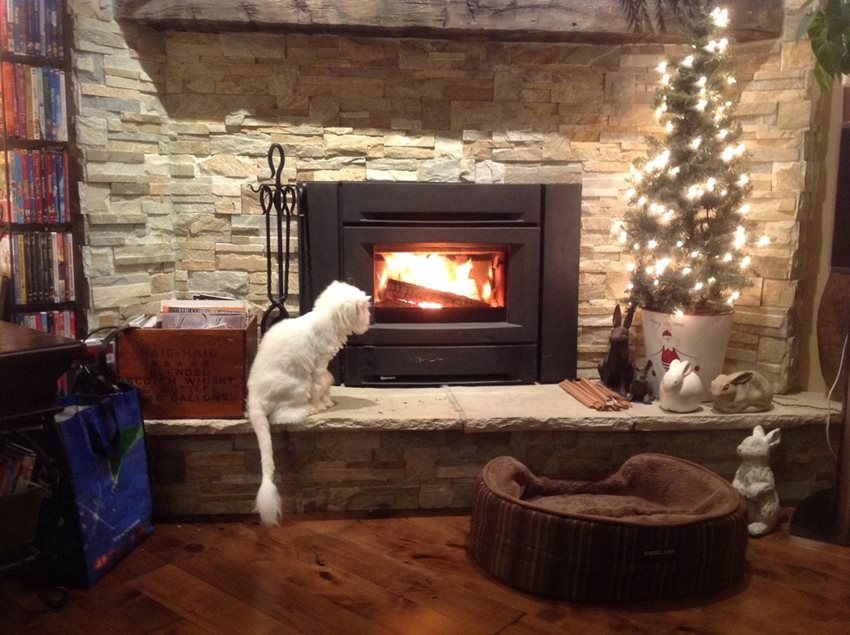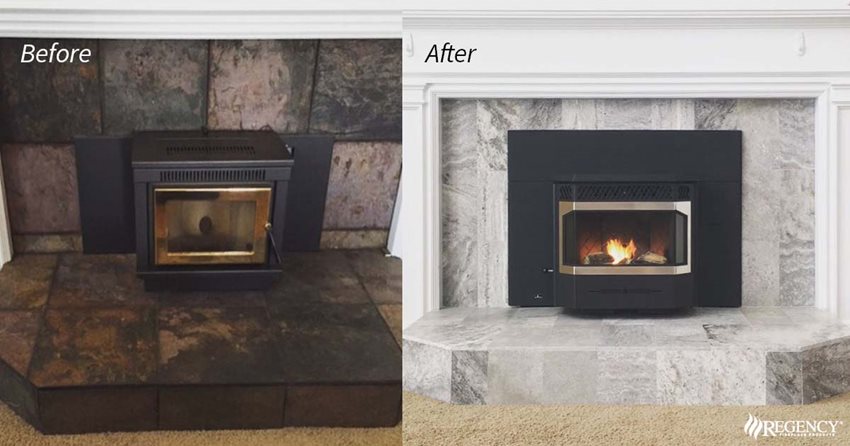Selecting a fuel source is one of the first decisions you'll make when you visit
your local fireplace store. Here are some things to consider when trying to decide what fireplace fuel is best for you:
WOOD
.aspx) Choose wood if you love the crackling sound and dynamic ambience of a real wood fire, and you have a place to store wood logs!
Environmental Efficiency
Choose wood if you love the crackling sound and dynamic ambience of a real wood fire, and you have a place to store wood logs!
Environmental Efficiency
When it’s sustainably harvested, wood is a renewable, carbon neutral fuel source. New technology has revolutionized the environmental efficiency of wood burning fireplaces, stoves and inserts. The most efficient wood inserts are EPA and 20/20 certified, which means they release very little particulate matter (smoke and ash) into the atmosphere. The cleanest burning wood inserts have
three stage combustion burn technology, a process that burns almost all smoke and ash completely so it doesn't get released into the atmosphere.
.aspx) Effort
Effort
Effort is needed to split and store wood logs and stoke a wood fire. To minimize the amount of effort required, you can source pre-cut logs and choose a wood fireplace, stove or insert that has three stage combustion burn technology like the
Pro-Series CI2700, which can burn one load of wood for up to 14 hours! Wood burn time is relative to the type and moisture content of the wood you use and the quality of your fireplace.
Maintenance
Other than annual chimney sweeping and the occasional glass clean, wood burning fireplaces require very little maintenance because they have no mechanical components to maintain. Thanks to the efficiency of three stage combustion burn technology, you won’t even have to empty the ash drawer very often. To minimize the time you spend maintaining your fireplace, choose a wood insert that has strong durable hinges and an adjustable door latch.
Cost/Affordability
Wood burning fireplaces, inserts and stoves are generally priced similar to their pellet and gas counterparts. In terms of fuel cost, unless you can source wood from Mother Nature for free, you'll have to pay for wood. To reduce the cost of your annual chimney sweep, pick a wood insert that has a limited number of removable parts. If you really want to minimize cost look for
fireplaces on sale near you before you buy.
.aspx) Pictured Above: Hi500
Flame Experience
Pictured Above: Hi500
Flame Experience
Wood is the only fireplace fuel that produces crackling noises and ambient glowing embers. The flames in a wood fireplace are dynamic. They flare high when new logs are introduced and when the draft is open, and they simmer low when logs have been burning for a while and when the draft is partially closed. Wood inserts don’t need fans to operate, but the best wood inserts have blowers that can be turned on or off at the home owner’s leisure. Blowers are a great way to instantly circulate warm air from your fireplace into the far corners of your room.
.aspx) Regency Fireplace Products guarantees their fireboxes for life.
Pictured Above: Ci2700
Heat Production
Regency Fireplace Products guarantees their fireboxes for life.
Pictured Above: Ci2700
Heat Production
Wood fireplaces, inserts and stoves burn hot, but the amount of heat generated will depend on the type and moisture content of the wood you use, the number of logs you put into your fireplace, and the quality and design of your fireplace. Some of the best
wood inserts,
fireplaces and
stoves are built from scratch using premium grade, thick raw steel.
Installation
Wood fireplace inserts can be professionally installed into existing masonry chimneys. Wood burning fireplaces and stoves can be positioned nearly anywhere in the home thanks to new venting technologies.
Requires Electricity?
No
.aspx) Pictured Above: I2450
Style
Pictured Above: I2450
Style
The style of wood fireplaces, stoves and inserts has evolved. In addition to new
contemporary models, premium manufacturers have also introduced customization into the marketplace. The customization options for wood burning fireplaces and inserts aren’t as plentiful as gas fireplaces and inserts, but depending on what model you select, you should be able to select from a variety of colors, backing plates and decorative accessories.
Safety ★★★★
If you purchase a
premium crafted wood insert, stove or fireplace from an
authorized dealer, install it professionally and maintain it as per your owner’s manual, your wood insert will perform safely and efficiency. Most accidents related to wood burning fires are preventable. Only burn approved materials in your wood insert and remember to wear gloves to prevent splinters and burns while stoking the fire.
 Pictured Above: Regency CI1150
I’ve had this fireplace for the past 3 years, love it! Put a gas fireplace in the basement and glad I did, don't have to drag wood down stairs but the upstairs wood insert is magical, one of my favorite things about winter. I clean the glass before every fire, no big deal because I love the clear view, every fire is different, it's art! The gas fireplace in the basement is just heat. I would say I burn 1/20th of the wood compared to when it was just an open fireplace, no more drafts. Fan's a bit loud but the heat it pumps out is awesome!
Cat loves it too…
- Rob (via Houzz)
Pictured Above: Regency CI1150
I’ve had this fireplace for the past 3 years, love it! Put a gas fireplace in the basement and glad I did, don't have to drag wood down stairs but the upstairs wood insert is magical, one of my favorite things about winter. I clean the glass before every fire, no big deal because I love the clear view, every fire is different, it's art! The gas fireplace in the basement is just heat. I would say I burn 1/20th of the wood compared to when it was just an open fireplace, no more drafts. Fan's a bit loud but the heat it pumps out is awesome!
Cat loves it too…
- Rob (via Houzz)
PELLETS
.aspx) Choose a pellet insert or stove if you want a renewable, carbon neutral fuel source and a fireplace you can operate via electronic controls.
Environmental Efficiency
Choose a pellet insert or stove if you want a renewable, carbon neutral fuel source and a fireplace you can operate via electronic controls.
Environmental Efficiency
Like wood, pellets are a renewable, carbon neutral alternative to fossil fuel. Made from compressed organic materials like wood, bark, corn, wheat and barley, pellets aren’t a new fireplace fuel, but they are becoming more popular. On the efficiency scale, the best pellet inserts are comparable to wood inserts that have three stage combustion burn technology.
.aspx) Effort
Effort
Aside from having to load the hopper (the place pellets are stored before they are burned) and regular maintenance, pellet inserts and stoves require minimal effort to operate. Similar to gas, most pellet stoves and inserts can be turned on/off and adjusted via electronic controls. To minimize how often you’ll need to load pellets into your hopper, choose a pellet insert that has a large hopper like the
GC60 or
GCI60. How often you load the hopper will depend on what temperature setting you select. The lowest setting on your pellet fireplace will burn approximately 1 ¼ lbs of pellets per hour, while the highest setting will burn approximately 5-6 lbs of pellets per hour.
.aspx) Maintenance
Maintenance
Used regularly, pellet stoves and inserts usually require annual and weekly maintenance. On a weekly basis you’ll need to clean the burn pot (the place where pellets are burned) and sweep ash off internal components to prevent air flow blockages that can decrease the efficiency of the unit or stop it from operating. Similar to a wood insert, you’ll also need to clean the glass on your pellet insert if you want to maintain a clear fire view. Because pellet inserts have several mechanical components, they require more maintenance. To minimize maintenance costs, maintain your pellet fireplace regularly as per your owner’s manual and pick a fireplace manufactured by a company that takes pride in quality.
.aspx)
Cost/Affordability
Pellet inserts, fireplaces and stoves are generally priced similar to their wood and gas counterparts. The operation cost of your pellet fireplace product will be relative to the efficiency and craftsmanship of the unit you buy, the quality and type of pellets you use, the cost of electricity in your region, and the heat setting you maintain. If you’re converting to pellet, review available
government eco-rebates and tax incentives and
fireplaces on sale near you before you buy.
Flame Experience
The flame produced by pellet inserts is vibrant and lively. Pellet inserts are generally quiet, but you may hear noise from the electric fans required to maintain airflow to keep the fire burning and/or the electronic powered belt that drops pellets into the burner.
 Pictured Above: GFI55
Heat Production
Pellet inserts
Pictured Above: GFI55
Heat Production
Pellet inserts are hot, consistent and efficient heaters. The amount of heat your pellet fireplace produces is relative to the efficiency and craftsmanship of the unit you buy, the quality and type of pellets you use, and the heat setting you maintain.
Installation
The only thing easier and cheaper to install than a pellet insert is a pellet stove. Pellet inserts install smoothly into existing masonry fireplace openings. They are more simple to install than gas fireplaces because they don’t require a fuel line.
Requires Electricity?
Yes
Style
The increasing popularity of pellet stoves and inserts is prompting new styles, but traditional and classic styles like the
GC60 and
GFI55 are still readily available. The best pellet inserts and stoves invite you to customize the look of your unit via various door overlays and faceplates.
Safety
If you purchase a premium crafted pellet
insert or stove from a reputable dealer, have it installed professionally, and you maintain it as per the owner’s manual, it should perform safely and efficiently. Pellet inserts and stoves score high in the safety department because you don’t need to open the viewing window to fuel them.
RECOMMENDED FOR YOU
How To Shop For A Fireplace: 6 Pro Tips
Government wood stove exchange programs, energy rebates & tax incentives
The 5 Stages of Fireplace Renovation